Change Resolution:
1024x768 or below

 :
: (11 & 3) 1986-1992
CPU: 3.6 MHz Z80
Audio: 4 Channels
RESOLUTION: 256 x 192
RAM: 8KB
Video RAM: 16KB
Colors On Screen: 32
Color Palette: 64
Sprite Max & Size: 64 at 32x32
Storage:
Sega Card (32KB)
Cartridge 4 Mbit (512KB)
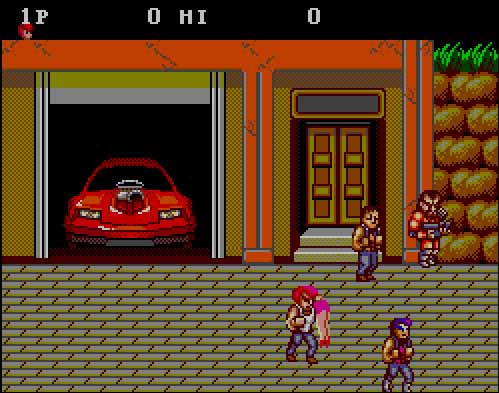
Jump to:
Comparison Page
Game List
 :
:
(3 & 12).†1985-1992
CPU: 1.79 MHz 6502
Audio: 4 Channels
Max RESOLUTION: 160 x 192
RAM: 2KB
Video RAM: 2KB
Colors On Screen: 16
Color Palette: 52
Sprite Max & Size: 64 at 8 x 16
Storage: Cart 4 Mbit (512KB)
Average: 1 Mbit
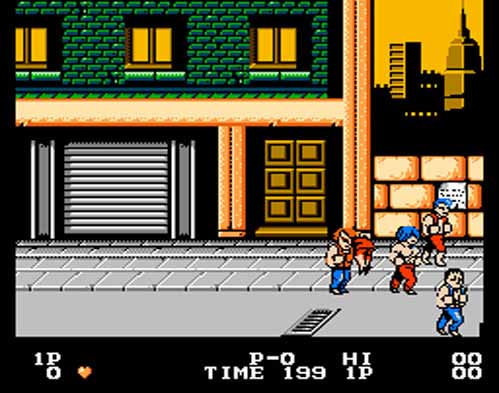
Jump to:
Comparison Page
Game List
Third party support for the Sega Master System (SMS) was comparatively small due to the illegal monopoly Nintendo had with the Nintendo Entertainment System (NES). Through licensing contracts for the NES, Nintendo made it so that no 3rd party publisher could make the same game they made for the NES for another console, and Nintendo was very prone to taking other companies to court to enforce this and any other legal issue(1 & 4).† In addition to all the third party games, the NES, not the SMS, had a defect rate of up to 30% per shipment(4).
With the NES being what it was, there is actually no need to reiterate what is stated on virtually every video game related web page about it. The Sega Master System was the place to go for the first role playing game for a console in the United States, Phantasy Star (1). Even though it was first in the US, Phantasy Star contains innovative features such as animated 3D dungeons, five save anywhere save slots, and a female heroin.
The reason for pointing all of this out is because the SMS was a total marketing failure for Sega in Japan and the United States. However, it actually dominated well into the mid 90's in Europe, Australia, New Zealand and Brazil. Many more Master system games were made for these markets that are actually compatible without modification with US Master Systems.
There are several theories as to why the SMS was not a success in the United States. One very plausible reason is Nintendo's monopolistic licensing contracts with 3rd parties. This left the SMS without popular 3rd party titles available on a large enough scale to compete with the NES library.
The SMS was Sega's first entry in the Video Game console market in the United States and was the most powerful 8-bit hardware. Sega and a handful of other big name 3rd parties supported the Master System with exclusive arcade and home-only game-titles, adding up to over one hundred titles. 13 Million SMSs were sold worldwide from 1985-1998, and US support for the console was cut off around 1992 (1). The Nintendo Entertainment System sold something around 50 million worldwide, and seven hundred and sixty-one games were released for it ( 21 ).
In regard to what people were actually playing on each system, according to reviews online, over one hundred of the final US SMS library have been noted as having unique or highly polished gameplay, in such a way that they have received a recommendation from reviewers today. On the other hand, roughly three hundred of the NES's final library of seven hundred and sixty titles have been recommended for similar reasons. It is worth noting that from 1986-1988, the SMS and NES had roughly the same number of titles which people have felt worth mentioning. The majority of the NES's vastly larger library, and its lead in notable game titles, was gained after 1989, when the 16-bit era had already begun and no other 8-bit platform was on the market to compete.
NEC  :
:
( 29, 30, 32) 1989-1993
CPU:Two 3.6 MHz 8-bit HuC6280
(CPU + Sound, custom 6502)
Audio: 6 Channels
CO-PROCESSORS:
Video Processor: 16-bit HuC6270
Color Processor: HuC6260
RESOLUTION: 256x256 or 320x256
RAM: 8KB
Video RAM: 64KB
Colors On Screen: 482
(16 Colors per sprite or background)
Color Palette: 512
( 16 Palettes of 16 colors each)
Sprite Max & Size: 64 at 32x64 pixels
Background Planes: 1
4+ possible in software
Storage: HuCard 16Mbit (2.5MB)
Average 4 Mbit
 :
:( 29, 30, 32) 1989-1993
CPU:Two 3.6 MHz 8-bit HuC6280
(CPU + Sound, custom 6502)
Audio: 6 Channels
CO-PROCESSORS:
Video Processor: 16-bit HuC6270
Color Processor: HuC6260
RESOLUTION: 256x256 or 320x256
RAM: 8KB
Video RAM: 64KB
Colors On Screen: 482
(16 Colors per sprite or background)
Color Palette: 512
( 16 Palettes of 16 colors each)
Sprite Max & Size: 64 at 32x64 pixels
Background Planes: 1
4+ possible in software
Storage: HuCard 16Mbit (2.5MB)
Average 4 Mbit
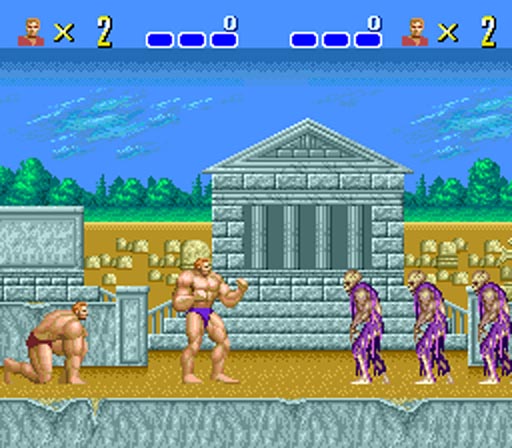
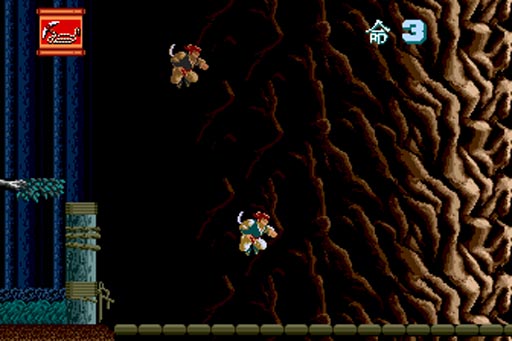 Jump to:
Jump to:Comparison Page
Game List
Screenshots
Arcade Port Comparisons
Turbo CD/DUO
The TurboGrafx-16 was released in 1989 in the US, the same year that the Sega Genesis was released. Despite its apparent lack of hardware prowess and it's 8-bit central processors, the TurboGrafx pulled off impressive visuals with nearly twice the colors on screen than the Super Nintendo (1991), software scaling in games like Afterburner (Japan), and impressive numbers of parallax backgrounds in shooters as early as 1990. The TurboGrafx demonstrates a significant edge in horsepower over the later released SNES, and with the Genesis' color limitations it can be said that NEC had a very competitive product. Simply put, the TurboGrafx was poised to take the lead of the next generation console race.
Having been released one year before the Megadrive (Japanese Genesis) in Japan, by 1989 the PC-Engine already had hundreds of software titles released and ready to be translated and localized for the US market. Unfortunately, for gamers especially, the vast majority of these software titles never got localized, at least partially due once again to Nintendo's aforementioned illegal licensing contract with virtually every third party developer. At the same time, there were excellent ports of many of Sega's top arcade games, many of which Sega could not allow to be released in the States for their competition's console. This left the TurboGrafx with a fine, but relatively small, selection of titles from NEC and Hudson Soft's own efforts. The final library simply pales in comparison to what was available for the PC-Engine in Japan, which had many superior versions of both Genesis and NES titles that very easily could have propelled the TG16 to success in the US.
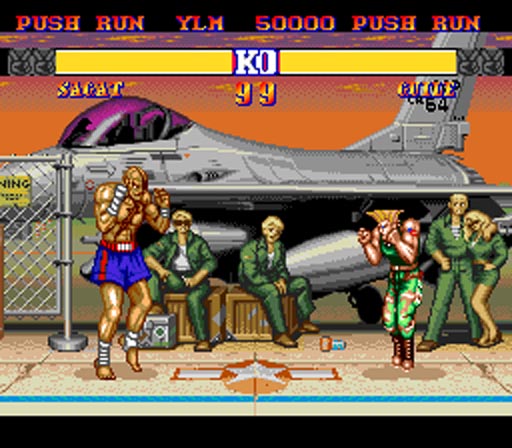
NEC took a PR stance that they were only going to release the "best of the best" PC-Engine titles locally, but it is evident that what few titles didn't fall under Nintendo's contract were too few to make a console successful. Despite this fact, NEC opted to release the CD-ROM add-on for the TurboGrafx, which added an additional potential library of over one hundred CD-ROM titles, including excellent RPGs. While NEC promised an affordable price for this CD-ROM add-on, the list price for the Turbo CD ended up being $399, and much like the Sega Master System it was relatively difficult to find on store shelves. Adding to that was the fact of NEC's localization efforts, for the add-on's Japanese library, being so select that the game media paints a picture of NEC not localizing a number of quality titles arbitrarily.
Whatever the management issues might have been, both the TurboGrafx and the Turbo CD-ROM were left with decidedly few titles in comparison to the Genesis alone. The media made certain to advertise this, and the consumer apparently took it to heart. The TurboGrafx-16 sold only approximately 2.5 Million units in the US by 1993, and the Sega Genesis eventually sold over 20 Million. This is effectively where the marketability of the TurboGrafx began and ended. Yet there was one final push for the system in 1992, when Turbo Technologies Inc launched the Turbo DUO. The tale of this system will be discussed in greater detail in its own section.

 :
: :
:
(5, 6, 13, 33) 1989-1995
CPU: 7.6 MHz 68000
CO-PROCESSORS:
3.58 MHz Z80 (Sound or Graphics)
TI 76489 (PSG)
Yamaha YM 2612 (FM):
10 Channels
Audio RAM: 8KB
VIDEO: VDP
Hardware Shadow and Lighting
Hardware Warping and Rotation
Max RESOLUTION: 320 x 224
RAM: 64 KB
Video RAM: 64 KB
Colors On Screen: 64
Color Palette: 512
Sprite Max & Size: 90 at 32 x 32
Background Planes: 2
(6-10 seen in Sonic 2)
Storage: Cart 32Mbit (4MB)[40Mb-SSF2]
Avg: 4Mbit ('89-'91), 8-24Mbit ('92-'95)
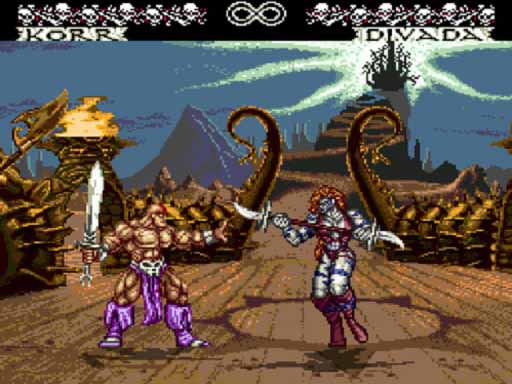

(7, 14, 33) 1991-1997
CPU: 3.58 MHz 65816
CO-PROCESSORS: Sony SPC700:
8 ADPCM Channels
Audio RAM: 64KB
VIDEO: 16-Bit PPU
Hardware transparency (lighting and effects)
Hardware Scaling (background or sprite),
Warping and Rotation ( speed limited by CPU )
RESOLUTION: 256x224
Max RESOLUTION: 512 x 418 (16-color)
RAM: 128 KB
Video RAM: 16 KB
Max Colors On Screen: 256
Color Palette: 32,768
Sprite Max & Size: 60 at 64 x 64
Hardware Sprite limit: 128
Background Planes: 4 (5 in some Software)
Storage: Cart 32Mbit (4MB)
Average: 8 Mbit to 16 Mbit
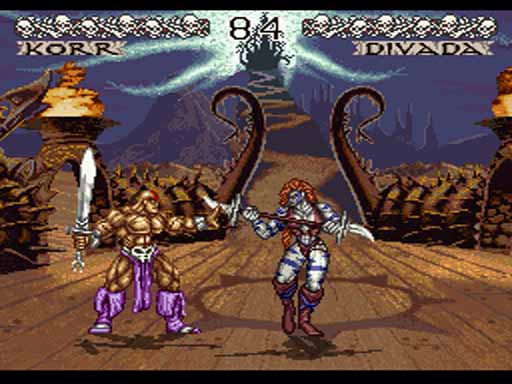
Jump to:
Game List
Screenshot and Audio Comparisons
Arcade Port Comparisons
Sega CD
According to game magazines of the day, the first SNES game to actually display 256 colors on screen was Super Street Fighter 2, years after the system's release. Until later in its life, the SNES only displayed 256 colors in limited scenes, such as the last boss fight in Final Fantasy II or the title screens of some games and not in most gameplay scenes. Most SNES games ran in the 90-120 colors on screen range. By the time of the SNES' release, the Genesis had overcome its color limitations by using shadow and lighting effects to cause the illusion of more colors in games like Castle of Illusion and Sonic the Hedgehog. Later in the Genesis' life cycle developers had developed methods for using the NTSC format's blurring effect to blend pixels into effectively displaying 128-256 colors on screen in games like Gunstar Heroes and Ranger X.
Without going into what is and isn't a perceivable color count difference, the SNES was limited to 2 background planes and 1-2 foreground planes if it was going to display 90-120 colors on screen, 2 planes if it was displaying 256 on screen with 16 color character sprites, or 1 if it was displaying 256 color sprites (the later two Donkey Kong Country used). The Genesis actually displayed between 6-10 independently scrolling planes with 64 colors on screen, which is demonstrated in many games, such as Lightening Force, Sonic 2 and Shinobi III. Both the Genesis and SNES were limited to 16 colors per character sprite in most games, most notably Street Fighter Turbo and Super Street Fighter 2.
The Genesis-vs-SNES page listed under comparisons on this site has more on the graphical and audio differences between the two systems. The pictures shown above are from both system's version of WeaponLord, released in 1995 at the end of both system's cycle.
The reader will conclude what you will, knowing that it is demonstratably true that the SNES could actually display 2-3X the colors on screen, while the Genesis could display 2-3X the sprites and independently scrolling 2D planes. The SNES could scale and rotate one 256 color plane, or scale and rotate sprites in whatever game the developer chose to implement this hardware feature in. Alternately, the Genesis typically had less slowdown, was capable of creating faster scrolling levels on average, could rotate sprites and backgrounds, and use its chip speed advantage, and the 3Mhz Z80 chip, to create custom special effects, scale grounds, and generate polygons without any cart loaded processors. The Genesis' software effects are best seen in Contra Hard Corp, Castlevania Bloodlines, Batman and Robin, Ranger X, Sonic 3D Blast's bonus levels, LHX Attack Chopper, and Red Zone, for starters.
 The Genesis has the largest library,
and eventually gained the most third party support of any Sega console, and
the Super Nintendo ultimately had a larger worldwide library. Many have claimed
that the SNES was the console to own for RPGs,
while the Genesis had the action
genre packed with it's arcade ports, and unique home offerings like the Shinobi
and Streets of Rage series. It is certainly true that the SNES has more
top quality RPGs available for it in the US. The Genesis was also home to exclusive
RPGs like Sword of Vermillion, Phantasy Star
1-4, Shining in the Darkness, and Shining Force 1+2, amongst other notable series
like Super Hydlide, Ys, and D&D. There was also Lunar the Silver Star and
Lunar Eternal Blue, along with other Working Designís localization efforts of
Game Artís games on the Sega CD.
The Genesis has the largest library,
and eventually gained the most third party support of any Sega console, and
the Super Nintendo ultimately had a larger worldwide library. Many have claimed
that the SNES was the console to own for RPGs,
while the Genesis had the action
genre packed with it's arcade ports, and unique home offerings like the Shinobi
and Streets of Rage series. It is certainly true that the SNES has more
top quality RPGs available for it in the US. The Genesis was also home to exclusive
RPGs like Sword of Vermillion, Phantasy Star
1-4, Shining in the Darkness, and Shining Force 1+2, amongst other notable series
like Super Hydlide, Ys, and D&D. There was also Lunar the Silver Star and
Lunar Eternal Blue, along with other Working Designís localization efforts of
Game Artís games on the Sega CD.  :
:
( 29 + 30) 1990 + 1992
CPU:Two 3.6 MHz 8-bit HuC6280
(CPU + Sound, custom 6502)
Audio: 6 Channels plus CD Audio
CO-PROCESSORS:
Video Processor: 16-bit HuC6270
Color Processor: HuC6260
CD-ROM Processor: 16 MHz 65802
RAM: 256KB (Super System Card)
2MB (Arcade Card)
Colors On Screen: 482
(16 Colors per sprite or background)
Color Palette: 512
( 16 Palettes of 16 colors each)
Sprite Max & Size: 64 at 32x64 pixels
Background Planes: 1
4+ possible in software
With an initial asking price of $399 and significant scarcity, and with a relatively small library of notable titles localized, the Turbo CD-ROM add-on did not sell well with the media or the consumer. In 1992 Turbo Technologies Inc repackaged both the TurboGrafx-16 and its CD-ROM attachment into one $199 system dubbed the Turbo DUO. By then Nintendo's illegal contract with 3rd parties was at an end and TTI specifically marketed the Turbo DUO against the Sega CD add-on for the Genesis. With a much larger library of games still begging to be localized the DUO certainly could have left Sega in the dust. At the end of the day, this is not what happened. TTI's localizations were as slim as NEC's before them, and the Sega Genesis had already captured the public's attention to such a degree that even the Super Nintendo took years to catch up to it, if it did at all in the US.
The Turbo DUO was forgotten by the masses almost as soon as it was released, and yet it remains a hard-core and import gaming favorite. This is because of a large import library and the type and quality of titles released locally. The PC-Engine/DUO in Japan is credited as the reason the Sega Megadrive (Genesis) failed to take hold there. The large library of titles available to import includes Dracula X: Rondo of Blood, the game which inspired the critically acclaimed Castlevania Symphony of the Night on the Sony Playstation.
The Turbo DUO's success amongst gamers is all the more evident in that the Turbo consoles are still available new for sale online at http://www.tzd.com/. Sale price for a Turbo DUO in 2005 range as high $400 new in box, $300 average, and importing a PC-Engine DUO will cost over $150 with shipping. In a world that sells the NES and SNES for $50, and the Genesis console and its games are all but forgotten by the masses, the Turbo DUO sells for more than its initial retail value. Thus, while the TurboGrafx-16 and its add-ons were utter marketing failures, they also are perhaps the greatest success story from a gaming perspective. Having been killed by the fickle and abstract rules of business and marketing, the Turbo systems maintain high demand and value with gamers regardless.
 :
:(8) 1992-1995
CPU: 12.5 Mhz 68000 CPU
(synced with Genesis CPU)
Hardware scaling and rotation, speed limited by CPU
RESOLUTION: 320x224
RAM: 768 KB plus Genesis RAM
Hardware Colors On Screen: 64
Max Colors On Screen:
128 using Hold and Modify
FMV Colors On Screen:
17 default, 256 Cinepak & Truvideo
Color Palette: 512
Sprite Max & Size: 90 at 32 x 32
128K RAM 1X CD-ROM drive
Screenshots
Screenshots
The Sega CD was the most successful add on ever made by any company, selling at 2.5 Million in the US from 1992-1995(8). Incidentally, the Sega CD and its software was selling moderately well in 1993, until Nintendo turned in a video of the Genesis version of Mortal Kombat (Acclaim) and the Sega CD game Night Trap (Digital Pictures) to Senator Lieberman. Senator Joseph Lieberman(D) then lead a very public witch hunt against violent video games, and pointed at Sega as the primary designer of such games. Despite Sega responding by creating the video game ratings board that eventually turned into the ESRB that all games are rated by today, sales of Sega CD hardware and software virtually stopped, and Sega Genesis sales began a gradual decline immediately following the televised Senate hearings(8).
By selling as well as it did, the Sega CD was also the first add-on or console to introduce the CD medium to the masses, in the United States in the form of a console. The Sega CD also made some very notable additions to the Genesis' hardware features(8). These included hardware scaling and rotation, over twelve times the RAM that the Genesis has, a SNES like Mode 7 scrolling technique also in hardware, streaming audio, and the advantages of the CD mediumís massive storage capacity, when compared with 512KB carts.
The Sega CD was supported through 1995, primarily by Sega, Core and Working Designs and has a library of over 200 games including the Lunar Series, Sonic CD, Final Fight CD, Silpeed, Snatcher, Popful Mail, Shining Force CD, Dark Wizard, Rise of the Dragon, Thunder Strike, and Soul Star, amongst many more average titles like Terminator, Wolf Child, WonderDog, which featured a nearly endless variation of enemies, BC Racers, Batman Returns CD, and a number of Full Motion Video titles. It was also the Sega CD which inspired Nintendo to go to Sony for their CD add-on for the SNES, which eventually led to the Sony Playstation(8).
If you bought the Sega CD Model 1 at launch for $300, and only the 17 games listed above, the Sega CD hardware would have cost you $17.64 per game. Since the CD-ROM games were all priced at $50 or less, that would be $67.64 per game. Many cartridge games, especially the SNESís chipped games, cost well into the $70 range at original retail.
Atari  :
:
(25) 1993-1996
PROCESSORS 1-3:
"Tom"
26.591 MHz 32-bit RISC Graphics Processing Unit
with 4K bytes of internal SRAM
- Three 64-bit RISC chips:
Object processor, Blitter, & DRAM memory controller
PROCESSOR 4:
"Jerry"
26.6 MHz 32-bit RISC Digital Signal Processor
8K bytes of internal SRAM
16-bit Stereo digital to analog sound processing
PROCESSOR 5:
13.295 MHz Motorola 68000 control processor
RAM: 16 Mbits (4 chips w/ 512KB) DRAM
RESOLUTION: 320x240 or up to 800 pixels per line
SPRITES: Up to 1,000 pixels wide/tall, numbers limited by the Object Processor.
POLYGONS: "10,000 Gouraud shaded, large, 65536 color, any shape per sec,"
Theoretical limit of 20,000 to 40,000 texture-mapped
Storage: Cart 48Mb (6MB)
Max Colors On Screen: 16,777,216
2X CD-ROM upgrade available
 :
:(25) 1993-1996
PROCESSORS 1-3:
"Tom"
26.591 MHz 32-bit RISC Graphics Processing Unit
with 4K bytes of internal SRAM
- Three 64-bit RISC chips:
Object processor, Blitter, & DRAM memory controller
PROCESSOR 4:
"Jerry"
26.6 MHz 32-bit RISC Digital Signal Processor
8K bytes of internal SRAM
16-bit Stereo digital to analog sound processing
PROCESSOR 5:
13.295 MHz Motorola 68000 control processor
RAM: 16 Mbits (4 chips w/ 512KB) DRAM
RESOLUTION: 320x240 or up to 800 pixels per line
SPRITES: Up to 1,000 pixels wide/tall, numbers limited by the Object Processor.
POLYGONS: "10,000 Gouraud shaded, large, 65536 color, any shape per sec,"
Theoretical limit of 20,000 to 40,000 texture-mapped
Storage: Cart 48Mb (6MB)
Max Colors On Screen: 16,777,216
2X CD-ROM upgrade available
There were less than 70 titles released for the Jaguar, including the Jaguar CD add-on. It was also the first of two consoles Electronic Arts never developed for although they had announced several games for the Jaguar CD; the other unsupported console would be the Sega Dreamcast. The Jaguar ultimately failed to gain significant market share or developer support. It did, however, enjoy the success of well made titles such as Alien vs Predator, Iron Soldier (and the much later released Iron Soldier 2), the best console version of the original Doom (marked off by EGM in favor of the incomplete 32X version), the famous Tempest 2000, amongst a few other fan favorites. The loving Jaguar spec worship of fans remains strong to this day, with a whole host of websites dedicated to Jaguar games, and hardware discussions.
"The memory, bus, blitter and video processor were 64 bits wide, but the processors (68k and two custom risc processors) were 32 bit.
The little risc engines were decent processors. They had some design hazards that didn't get fixed, but the only thing truly wrong with them was that they had scratchpad memory instead of caches, and couldn't execute code from main memory. I had to chunk the DOOM renderer into nine sequentially loaded overlays to get it working (with hindsight, I would have done it differently in about three...).
If the Jaguar had dumped the 68k and offered a dynamic cache on the risc processors and had a tiny bit of buffering on the blitter, it could have put up a reasonable fight against Sony."
 :
:(26 + 27) 1993-1996
CPU:
12.5Mhz 32-BIT RISC (ARM60)
Roughly equivalent to a 25Mhz 68030 or a fast 386
CO-PROCESSORS:
Two 25Mhz video Co-processors
Math Co-Processor for fixed-point matrix operations
16-bit DSP for sound
RAM: 2 MBytes
Video RAM: 1 Mbyte
RESOLUTION: 320x240 or 320x480
640x480 interpolated
POLYGONS:
20,000-25,000 Texture mapped,
30,000 theoretical
CD RAM: 32KB 2X CD-ROM
Max Colors On Screen: 16.7 million colors
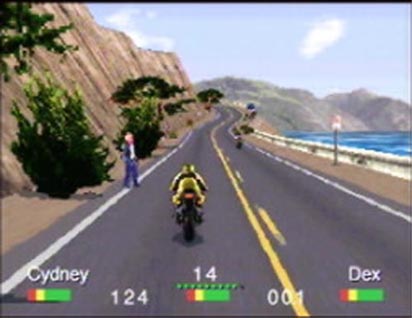
The 3DO was released by the 3DO company, which was co-founded and owned by Trip Hawkins, who also owns the popular software publishing house Electronic Arts. Electronic Arts, after forcing its foot in the door with a special licensing agreement for the Sega Genesis, had decided to create not just a new console, but "the" new standard architecture which would be licensed out to whoever wanted to manufacture it. The idea behind the 3DO was that it would be the next big entertainment format, "first there was audio, then video, now 3DO (threedeo).
"It will be more stimulating to the human mind than any new technology
since printing." - Trip Hawkins
The 3DO did not focus on 3D gaming, but a blend of 2D, FMV and 3D, like an advanced and much more expensive Sega CD. With more than 200 titles released for the architecture in its three year life span, the 3DO was certainly no failure by any standard considered here. Hopeful arguments have been made that the 3DO was just as capable for what was to come as the Playstation and Saturn, and the 3DO did seem more capable of rendering 3D with high color textures and high resolution, at least in some of its more exemplary software.
The initial asking price, from Panasonic's 3DO, of $700+ is most often cited as the reason for its ultimate failure to gain significant market share, and a general lack of software people wanted to play is the other most common complaint against the system. Much like the Sega CD, the 3DO's heavy focus on FMV gaming gave it a reputation that was difficult to overcome, even with excellent 2D offerings like Samurai Showdown, Super Street Fighter 2, The Horde, and 3D offerings like Offworld Intercepter, Star Fighter, the original Need for Speed, Road Rash 3D, and Fifa Soccer.
The best resources online for 3DO still in existence are the 3DO web ring, which consists of a series of fan pages that focus more on pictures of the different iterations of the 3DO than on the games, or screenshots of games, and Gamefaqs' pages with user reviews. The two cited links above the system specs have links to the FAQ, and discussions on Usenet, which is where all of the comments here are quoted from.
 :
:(9) 1994-1995
CPU: Two 23 MHz 32-bit RISC (Hitachi SH-2)
Optional overlay of Genesis graphics:
CO-PROCESSORS:
7.6 MHz 68000
3.58 MHz Z80 (Sound or Graphics)
TI 76489 (PSG)
Yamaha YM 2612 (FM):
10 Channels + 2 Digital channels (32X)
RESOLUTION: 320x224
RAM: 512 KB plus Genesis or Sega CD RAM
POLYGONS:
25,000 texture mapped per second
50,000 theoretical (box specs)
Max Colors On Screen: 32,768
Color Palette: 32,768
Storage: Cart 16 Mbits to 32 Mbits, or 1X CD-ROM
Marketing performance: 23 MIPS per SH-2
Screenshots
The only other Sega add on, the 32X, features twin 23Mhz SH-2's, making the Genesis 32X combined with the Sega CD from two years prior arguably more powerful than the much more expensive 3DO. The Genesis 32X alone is certainly more capable of high color 2D and 3D gaming in absolutely every respect to the SNES even with its on cartridge processors like the DSP or Super FX 1+2 chips that were used in games like Pilot Wings, Super Mario Kart, Star Fox, Yoshi's Island, Stunt Race FX and others.
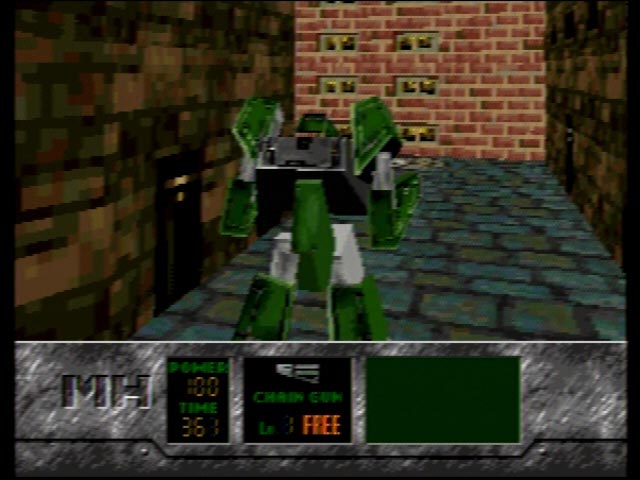 When the 32X add on launched the following months brought titles like Virtua Racing Deluxe,
Shadow Squadron, T-Mek, the
first near perfect arcade ports of Space Harrier
and After Burner, NBA Jam, arguably the best
home conversion of Mortal Kombat II, Knuckles
Chaotix, Star Wars Arcade, and a good version of Doom
from the PC. The total library added notable titles like Virtua
Fighter, Kolibri, and a little over one dozen
others in it's 1 year life span. Despite its launch library being technically
superior to what was available on 16-bit systems that Fall, the 32X sold less
than 250,000 units total, with only 500,000 shipped to retailers in the first
place.
When the 32X add on launched the following months brought titles like Virtua Racing Deluxe,
Shadow Squadron, T-Mek, the
first near perfect arcade ports of Space Harrier
and After Burner, NBA Jam, arguably the best
home conversion of Mortal Kombat II, Knuckles
Chaotix, Star Wars Arcade, and a good version of Doom
from the PC. The total library added notable titles like Virtua
Fighter, Kolibri, and a little over one dozen
others in it's 1 year life span. Despite its launch library being technically
superior to what was available on 16-bit systems that Fall, the 32X sold less
than 250,000 units total, with only 500,000 shipped to retailers in the first
place. The 32X add on was actually an answer to public and media demand, but was rejected by the public first, arguably in favor of a single game on the SNES, Donkey Kong Country(9). Software developers then began canceling their announced projects. Konami canceled their highly anticipated port of the Turbo Duo version of Castlevania Rondo of Blood, and Capcom canceled a highly anticipated a port of Super Street Fighter 2. Only after all 3rd party software developers had abandoned the 32X add on did Sega cease to manufacture and support it.
At this point Sega of Japan allegedly began to panic from declining Genesis sales world wide and the impending arrival of stand alone 3D game consoles. Sega of America's practice of overspending on marketing under Tom Kalinske, to overtake Nintendo's public mindshare, might have paid off if the Genesis were allowed to sell in to 1997. Less than 10 months after the 32X's release, Sega of Japan took over management and focused all resources on the Sega Saturn. Kalinske and his management team, who are regarded by media generated histories as being responsible for the Genesis' success in the States, subsequently resigned from their positions in Sega's American branch. This left Sega as a whole in financial debt and without a seasoned management team in America going into the next generation. Without the momentum of popular support from the Genesis to propel the Saturn into marketing success, or sufficient marketing dollars and experience in the US, Sega was ill prepared to defend its position not only against Nintendo, but against 3DO and Sony as well. Marketing dollars were, and are, particularly important in staving off harsh criticism from the video game media. An overview of Electronic Gaming Monthly and Gamepro from summer of 1994 through 1995 shows a concurrent decline of Sega related advertising and a steep increase in editorials that painted Sega in a negative light.
Regardless of public opinion of the add-on, the 32X was a cost effective and powerful expansion to the Genesis with more games available in its launch months than the Genesis or SNES enjoyed. One of the 150,000 people who bought a 32X at $160 might have also bought all twelve of the critically acclaimed games listed above and thus divided the cost of the add-on. Since 32X cartridges were all $50 each when they first launched, though they quickly dropped to less than $20 a game, each game would have cost $63.33 with the price of the 32X divided among them. That might seem like a lot for a game, but it is still less than the technically inferior SNES chipped games which were near $70 or more not including any hardware. With each additional purchase of a SNES FX chipped game the Super FX hardware was purchased again. So the actual cost per Super FX game would not go down as the library increased. Because the price per game did go down for 32X games, the argument for or against either format being a "rip off" could go either way. These facts failed to prevent gaming magazines from using the 32X to further sully Sega's reputation just prior to the launch of the Sega Saturn and Sony Playstation.

 :
: :
:
(16) 1995-1998
CPU: Two 28.6 MHz, SH-2 32-bit RISC
CO-PROCESSORS: 20 Mhz SH-1
SCU (DMA and Control Processor)
Motorola 68EC000:
32 PCM Channels
8 FM Channels
Audio RAM: 512KB
VIDEO: VDP1, VDP2, DSP (geometry)
RAM: 2 MBytes
Video RAM: 1.5MBytes
RESOLUTION: Non-interlaced NTSC: 320X224, 320X240, 352X224, 352X240, 352X256, 640X224, 640X240, 640X256, 704X224, 704X240, 704X256 Interlaced: 320X448, 320X480, 352X448, 352X480, 640X448, 640X480, 704X448, 704X480
POLYGONS: 500,000 flat-shaded quads per second; 200,000, 8-bit (256 colors) texture-mapped (non-lighted)
CD RAM: 512 KB
Max Color Palette: 24-bit, or 16,777,216
Marketing performance: 50 MIPS (w/o DSP)
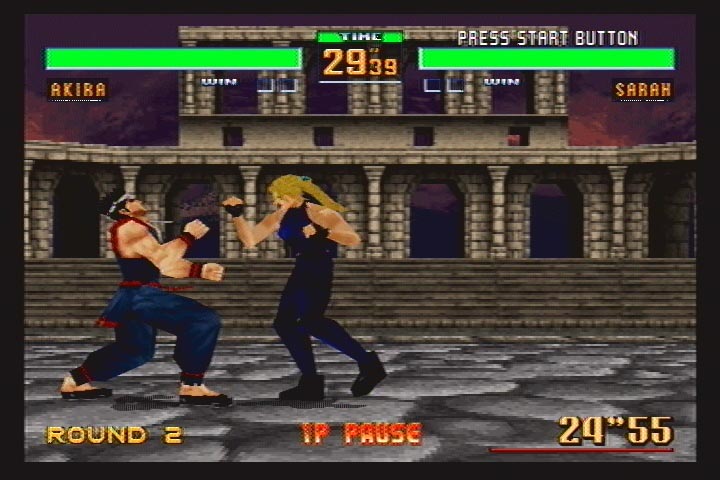
 :
:(15) 1995-2002
CPU: 33.86 Mhz 32-Bit RISC (R3000A)
CO-PROCESSORS: Geometry Engine
SPU: 24 PCM Channels
Audio RAM: 512KB
RAM: 2 MBytes
Video RAM: 1 MByte
RESOLUTION: non-interlaced 256X240, 320X240, 512X240, 640X240, 384X240 interlaced 256X480, 320X480, 512X480 640X480 384X480
POLYGONS:
360,000 flat shaded, triangles per second
180,000 texture mapped, 4-bit (16 colors) gouraud shaded per second. (225,000 in Iron and Blood)
CD RAM: 32 KB
Max Color Palette: 24-bit, or 16,777,216
Marketing performance:
30 MIPS Main Processor / 66 with GE
Additional information:
Saturn vs. PS1 comparison
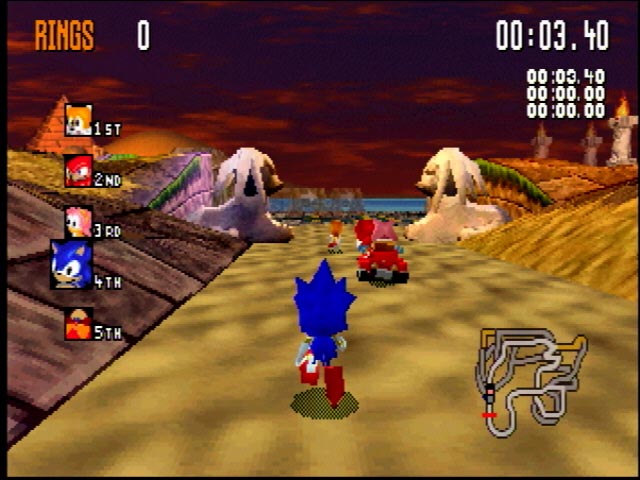 With
the Sega Saturn hardware got complex. Only stating
the Mhz ratings and estimated polygon limits doesn't do any console justice.
Ultimately, Sega advocated the multiple
CPU architecture during the Saturn days, and lost to Sony's simple CPU plus
GPU approach, which allowed for developers to make games much more quickly.† The Saturn vs PS1 was a battle fought on the
development Kits, and the Playstation
won, at least in sales.
With
the Sega Saturn hardware got complex. Only stating
the Mhz ratings and estimated polygon limits doesn't do any console justice.
Ultimately, Sega advocated the multiple
CPU architecture during the Saturn days, and lost to Sony's simple CPU plus
GPU approach, which allowed for developers to make games much more quickly.† The Saturn vs PS1 was a battle fought on the
development Kits, and the Playstation
won, at least in sales. Two significant changes occurred at the time of the Saturn's release, the complete replacement of 2D games with 3D games, and the switch from coding in assembly language for every game, to development on proprietary development Kits with cookie cutter special effects.
The Saturn had a significant edge on the next gen 2D games. The PS1 had comparatively weak 2D hardware ability. Many developers of sprite based PS1 games found the need to use it's 3D processes to simulate 2D. In other words, many 2D Playstation games were actually flat polygons with texture maps on them to simulate the look and feel of a 2D game.
The Saturn has many 3D games of greater or comparable technical prowess available for it. The Saturn library includes games that, to this day, run at higher resolution, both screen and texture, and frame rate than almost all of the PS1 library, in Virtua Fighter 2(704x480 res, 60FPS!), Sega Rally(High res high color textures, 30FPS), and Panzer Dragoon 2(640x224, 60FPS cut scenes). All of these games came out in the console's first Christmas season. Yet, with these games released in its first six months, the PS1 is the system that everybody, including developers, game magazines, and self proclaimed "enlightened" gamers on Usenet and web forums, will remember as being "vastly" superior in 3D performance to that of the Saturn. In the end, that massive public opinion, propagated by the media, is what sells consoles. There are a vast number of theories on why the Saturn failed to gain significant market share in the United States, they will be covered in the Saturn vs. PS1 comparison page listed under Comparisons on this site.
The Sega Saturn was launched earlier than announced, the same week as the Electronic Entertainment Expo in May of 1995. The launch surprised most retailers and all consumers, and was also a contributing factor to the launch games being somewhat incomplete at release, specifically Daytona. The initial asking price for the Saturn was $400, and dropped to $300 to match Sony's Playstation in September. Sales of both consoles were weak, compared to 16-bit console sales of the same time, until Final Fantasy 7 was released for the PS1 in August of 1997. 3 million Saturns had sold in the US by 1998, when Sega pulled the plug on it, and the PS1 took a year and a half to break the 1 million units sold mark in the US (10). Both the PS1 and Saturn sold comparably until Christmas of 1996, with the PS1 in a noticeable lead virtually the entire time. Despite this, developers began publicly dropping their Saturn projects as early as 1996 in favor of the quicker, easier to develop for Playstation 1. Ultimately the Saturn's sales stagnated and the Playstation's flourished and then exploded into the 60 million units sold, worldwide, monster that it was in 2000.
It's also important to note, even though the Saturn was discontinued after three years, that there were still a large number of titles that made the system worth the purchase. If you bought half of the games listed on the Saturn games page, and the console at original retail of $400, your Saturn would have cost you $9.30 per game, for a total cost per game of $59.30 at full retail. Very few people actually did this, or the system would have been a success.
 :
:
(31) 1996-2002
CPU: 64-bit MIPS R4300i RISC 93.75 MHz
CO-PROCESSOR:
Custom 64-bit MIPS RISC RCP 62.5 MHz
RAM: 4 MBytes (8MB with expansion)
(4 MB expansion supports 60 games)
POLYGONS: 160,000 Max
RESOLUTION: 256 x 224 to 640 x 480
Average 320x240
Marketing Performance: 125 MIPS
Floating Point Performance: 100 MFLOPS
Unique hardware effects:
Tri-linear Mip Map Interpolation, Perspective Correction, Anti-Aliasing, Z-Buffering
Storage: 16Mbytes to 32 MBytes (256Mbits)
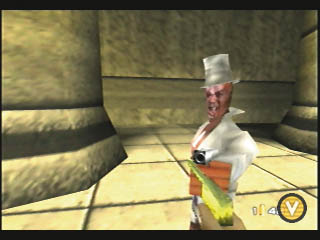
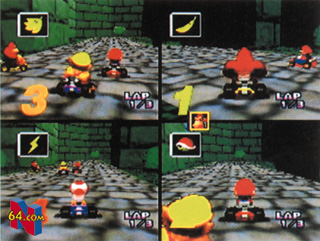 The Nintendo 64 can hardly be introduced without first going over the massive
marketing campaign that was Project
Reality. Nintendo claimed they would "combine three-dimensional graphics
of the quality seen in films such as Jurassic Park and Terminator 2, with high-
fidelity sound and an interaction speed around 10-15 times faster than the current
16-bit games." They also showed still shots of Silicon Graphics CGI with
cutouts of Mario, Luigi and cast pasted on them.
The Nintendo 64 can hardly be introduced without first going over the massive
marketing campaign that was Project
Reality. Nintendo claimed they would "combine three-dimensional graphics
of the quality seen in films such as Jurassic Park and Terminator 2, with high-
fidelity sound and an interaction speed around 10-15 times faster than the current
16-bit games." They also showed still shots of Silicon Graphics CGI with
cutouts of Mario, Luigi and cast pasted on them. The blatant lie that was the Project Reality vaporware, when compared to the actual Nintendo 64 is only matched, if not surpassed, but Sony's later Playstation 2 hype during the Dreamcast's 13 month lead. Contrary to Nintendo's claims of movie quality graphics, what was actually released was a roughly equivalent system to the Saturn and PS1, with the addition of 3D accelerated effects, courtesy of the young 3dfx graphics engine.
In addition to this, and much to the media and gamer's dismay, Nintendo opted to release a cartridge based system rather than use the CD-ROM format which was fast becoming Industry standard. This fact alone is often cited for the N64's failure in Japan, but the American audience apparently didn't mind too much, as the system sold relatively well in the States, selling nearly 18 Million units to the PS1's 22.7 Million. Similarly, even though Square themselves popularized the idea that only the PS1 could handle Final Fantasy VII's static screens, FMV and midi music, Capcom had no trouble getting Resident Evil 2 on the system complete with voice and FMV. Despite this, the media portrayed a Nintendo that was whistling to its own tune, utterly devoid of concern for where the Industry was going with hardware, and an N64 that was virtually devoid of 3rd party support as a result. This story is lent significant credit by the final release lists of both systems being far and away stacked, in numbers, on the Playstation side.
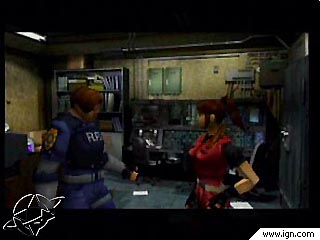
In reality, Nintendo saw the potential piracy hazard of the CD-ROM format, which was already breaking out in Mod chips for the PS1 and Saturn by the US N64 launch, and thus chose to stick to the much more secure cartridge format. This also gave significant financial perks in the manufacturing process and 3rd party licensing contracts. The media can and does say whatever it wants, but it was Nintendo that left this generation the most profitable. Meanwhile both Sony and Sega's divisions were in the red far more often.
Since the N64 has only 292 titles released for it total, and the PS1 has just a few dozen short of one-thousand more than that, discussions for or against the N64 skew in a like manner. Sony fans tend to repeat the old adage that they apply to the Saturn and Dreamcast, which have a similar quality and quantity in their libraries. That is that there were literally, or practically, no games for the N64 that made the system worth the purchase. As mentioned previously, the situation in the States was much more balanced than the media and Sony fans would portray. On the other end of the spectrum, Nintendo fans of the N64 would tend to state that Nintendo's "Quality over Quantity" PR saved the N64 from leagues of bad games, and that nearly every game in the library is an exceptional game. Obviously, both perspectives are off from the actual facts as much as popular opinions usually are.
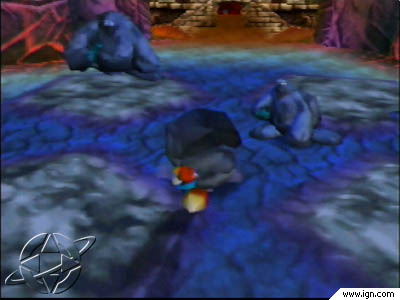 With the PS1 library topping out at roughly 1280, according to the sales
chart last posted on Usenet, and the Polls conducted on Usenet to attain
a list of notable PS1 games maxing out at just under 170
titles, Sony fans themselves admit a ratio of 1.3 games out of every 10
being memorable, notable, or of some level of exceptional polish in gameplay.
Not even adding every sports title made for the system would increase this ratio
past 3 out of 10 titles. Conversely, the average N64 owner would tend to stick
with first and second party titles, with notable exceptions of multi-platform
titles which were considered better on the N64, and the occasional exclusive
3rd party title. Going through the final release list, you'd get a ratio of
at least half of the N64's library being notable on the same grounds as the
PS1 list was founded. This means that, while every title clearly wasn't as good
as the next, the ratio of notable games on the N64 is much higher, and there
was much less confusing clutter on the shelf.
With the PS1 library topping out at roughly 1280, according to the sales
chart last posted on Usenet, and the Polls conducted on Usenet to attain
a list of notable PS1 games maxing out at just under 170
titles, Sony fans themselves admit a ratio of 1.3 games out of every 10
being memorable, notable, or of some level of exceptional polish in gameplay.
Not even adding every sports title made for the system would increase this ratio
past 3 out of 10 titles. Conversely, the average N64 owner would tend to stick
with first and second party titles, with notable exceptions of multi-platform
titles which were considered better on the N64, and the occasional exclusive
3rd party title. Going through the final release list, you'd get a ratio of
at least half of the N64's library being notable on the same grounds as the
PS1 list was founded. This means that, while every title clearly wasn't as good
as the next, the ratio of notable games on the N64 is much higher, and there
was much less confusing clutter on the shelf. In addition to this, it was Nintendo in this generation that innovated in gameplay controls first, with their analog stick being standard on every controller, and four controller ports being standard on every system. Not only did analog control catch on, but both Sony and Sega scrambled to get their own analog controller on the market after Nintendo revealed their innovation. Also, despite the N64's apparent similarities in power, it seemed to handle four-player split-screen remarkably well starting as early as 1996. This when combined with the average first party title being devoid of noticeable draw in, and having much larger levels than comparable PS1 and Saturn titles had early on, makes the N64 appear more powerful in software, regardless of spec comparisons.
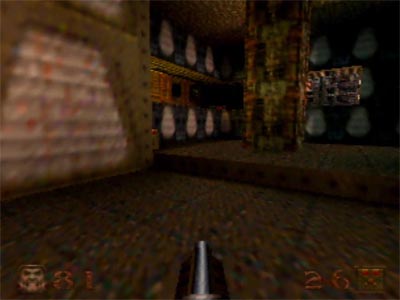
With that said, the N64 also suffers from the limited cart memory and lack of a sound chip, causing many games to have very blurry texture maps, and chip music inferior even to that of the Genesis or SNES. This makes for a kind of love-hate relationship with many cross platform gamers who love the N64 for it's multiplayer, lower load times, and 3D accelerated effects, but hate it for it's low texture resolutions and color counts, along with some game's overuse of the full screen blurring. No system is perfect, however the manufacturer and media would try to convince otherwise, and the N64 surely had its fair share of shortcomings, but at least this generation of gamer in the States rewarded with sales appropriately, which is unlike what they do in the next generation.
Dreamcast
 The World:
The World: :
:(17, 34, 35) 1999-2002
CPU: Hitachi SH4 128-bit RISC 200MHz
32-bit INT; 64-bit FP; 24KB L1
VIDEO:
NEC PowerVR Series II 100MHz
Tile Based Renderer
100M Texels/Sec
AUDIO:
Yamaha Processor
64 2D ADPCM Voices
Audio RAM: 2MB
RAM: 16 MBytes 800 MB/sec Bus
Video RAM: 8 Mbytes with 5:1 compression
POLYGONS: 3.5 Million, 5 Million Max
(As seen in Test Drive: Le Mans)
Max RESOLUTION: 640x480 at 32bit Color (VGA)
Games were not 32bit color
Unique hardware effects: (To PS2) FSAA
Marketing performance: 360 MIPS
Floating point performance: 1.4 Billion/GFLOPS
Storage: 1 GB GD-ROM (CD-Quality chip sound)
Networking: 56K Modem (Broadband expansion)
 :
:
(18, 34, 35) 2000-2007
CPU: 294.912 MHz 128-Bit "Emotion Engine"
128-bit INT; 128-bit FP; 24KB L1; 16KB Scratch
2.4 GB/s Internal; 3.2 GB/s Memory
CO-PROCESSOR: FPU (Floating Point Unit)
Vector Units: VU0 (8KB) and VU1 (32KB)
VIDEO:
Graphics Synthesizer 147.456MHz
1.2 GB/s to main memory
1.2G Texels/Sec
AUDIO: SPU2
48 2D ADPCM Voices
Audio RAM:2MB
RAM: 32 MBytes (MPEG2 Compression)
Video RAM: 4 MBytes no compression
40 GB/s to GS only
POLYGONS: 1 Million per second (1st year games)
3 Million per second (Average)
10 Million (non-game)
Max RESOLUTION: 640x400 at 32bit color
640x480 in many games (4bit to 8bit color textures)
Marketing performance: 450 MIPS
Floating point performance: 6.2 Billion/GFLOPS
66M Vertices/Sec
Storage: DVD (4.7GB) CD (650MB)
Networking: Broadband expansion
Jump to:
Game lists and Screenshot comparisons
PS2 Tomfoolery
Launch Comparison
Sega went the simple CPU + GPU route for ease of development when they made the Dreamcast. The DC verses the PS2 under "PS2 Tomfoolery" on this site has much more information than is necessary here. It can be said that the Dreamcastís games have and will continue to compare well against the PS2 library in both gameplay and graphics. The Dreamcast was simply designed for higher color, higher resolution textures, and ease of development. By comparison, the PS2 was relatively limited in texturing ability, and is relatively difficult to program for. Even as late as 2005, Capcom was forced to drop the polygon counts of the PS2 port of Resident Evil 4 from the Gamecube to between 900k to 1.5 million polygons per second, at 30 frames per second, while the Gamecube original ran at nearly twice this polygon count and twice the framerate ( 40, 41 ). Similarly, the Dreamcast vs PS2 page under comparisons shows well the superior effort put forth Dreamcast software releases.
Sony chose to go the multiple processor route with the PS2. Inside their "Emotion Engine" are a MIPS III core, two vector units, an image processing unit, a graphic interface unit, and controllers for memory and access to other parts of the PS2. Technically speaking, the idea behind the Emotion Engine is very similar to Segaís idea with the Saturn, except the helper processors are on the same chip with the CPU to increase bandwidth.
With the question of whether both systems were of comparable performance out of the way, the discussion of the market performance is much more one sided. Even when the Dreamcast was selling well on the market, reaching 1 million in less than 90 days and 4 million in 2 years, Dreamcast software was largely overlooked by the consumer. Yet Dreamcast software suddenly became very interesting to a lot of people when it became possible to download software for free, or in other words, when it became easy to steal software in the summer of 2000. This caused many developers to start canceling their future projects even before Sega announced that it would be discontinuing the system in February of 2001.
When the PS2 launched, many the Dreamcast fan scratched their head at the satisfaction Sony fans and the media experienced with SSX, as the only exceptional launch title. This is exemplary of the shift in gameplay focus that occurred at this time. No longer was gameplay the focus at all, and what replaced it was mood, edginess, thugery, and the cinematics required to create them. SSX carried the "urban" feel that Playstation owners craved more than graphics, more than innovative gameplay, and definitely more than a serious challenge, and games like Grand Theft Auto III exploded their expectations for dark, edgy, thug activity in a game.
In fact, despite the 13 month head start of the Dreamcast being completely inundated with hype exclusively in regard to the graphical capabilities of the PS2, once the PS2 launched the media and Playstation fans changed their tune completely. Nearly every major Dreamcast release had every game reviewer commenting on framerate and polygons per second, and actually rating a game down if the framerate stuttered at all. Yet once the PS2 launched, discussion of such things completely stopped. Not only were specs conveniently not important anymore, but neither was gameplay, all that mattered from then on was the "feeling" the products gave them. While there are always exceptions to a rule, gameplay would not become the primary selling point for any game for the rest of this generation.
At the Dreamcast's record breaking launch, Electronic Arts announced that it would not develop for it until it sold 1 million units. 90 days later, when the Dreamcast actually achieved that figure, again breaking records, EA announced that they would not develop for the Dreamcast at all. Also, when the Dreamcast launched in the US, and it was discovered that there was a bad pressing of game disks, Sega offered a free replacement solution to anyone who had a defective disk. Gamepro magazine had a multi-page spread about these defective discs, that conveniently left out the free replacement solution.
Comparatively, the PS2's "Disc Read Error" is a widely known problem that Sony has not made one statement on, and no so called news site or game related media has reported on this defect at all. In fact, even when Sony decided to settle a lawsuit against them for Disc Read Errors in PS2s, they still insist that there is no defect. Victims, or in Sony's world the "Settlement Class", of defective PS2's need to read http://www.ps2settlement.com/ and figure out for themselves whether they can get some of their money back from Sony.
The PS2 sold close to 20-million units worldwide from March 2000 to the spring of 2002, close to 7 million of those were in the US alone. Compare that to the Dreamcast's final numbers of less than 10 million worldwide, 4 million in the US, but launching in 1999 and discontinuing by December of 2001. Sega developed more games for the Sega Dreamcast themselves than any other individual developer, by nearly a factor of two, having made or published 60 titles for the US market from '99-'01. By comparison, Nintendo developed or published 51 titles for the N64 from 1996-2003. This is not Sega's best showing overall, since they developed or published 162 titles for the Genesis from 1989-1997, but over 20 unique and original titles a year is Sega's standard amount of release until they got out of the hardware business.
From the Dreamcast's cancellation on, Sega has become primarily a publisher of other developer's games, and uses its Dreamcast and NAOMI 1+2 gameplay engines to release sequels to popular franchises. These sequels are generally not considered to be as good as the originals, if they aren't a direct port of an original Dreamcast game. Simply put, the number of unique original titles available from Sega, dispersed across three consoles from 2001 on, is simply no comparison to when they were developing for their own consoles. Fans of these new consoles say that the one or two unique Sega titles that have come out per year, such as VF4 (PS2), or Outrun 2 (XBOX), or Monkey Ball (GC) make up for this descrepancy in numbers of unique titles over all. Yet they contradict themselves in that the rest of the time these groups, and the media, focus on sheer numbers of titles, rather than what games are actually good. Only a cynic would consider this development a good thing from a gaming perspective.
Microsoft  :
:
( 34, 38 ) 2001-2007
CPU: Intel P3 733MHz
32-bit INT, 80-bit FP, 64-bit MMX, 128-bit SSE, 32KB L1, 128KB L2
VIDEO:
NVIDIA XGPU 233MHz
1.9G Texels/Sec, 3.7G Samples/Sec
DX8 Shaders, Compression, FSAA, 32-bit Color
6.4 GB/sec Bus,
AUDIO:
NVIDIA MCPX
256 2D Voices, 64 3D Voices, Dolby Digital
RAM: 64MB (6.4 GB/s)
Video RAM: Unified with main RAM
POLYGONS: 6 Million per second (Max in Game)
3 Million per second (Average)
RESOLUTION: 640x480 32bit color (NTSC)
480p/720p/1080i (HDTV)
Unique hardware effects: (To PS2)
FSAA, DX8 shaders
Marketing performance: 1980 MIPS (CPU)
Floating point performance: 80 GFLOPS, 106M Vertices/Sec (NVIDIA)
Storage: DVD (8.54GB), 8GB HDD
Networking: Broadband
( 34, 38 ) 2001-2007
CPU: Intel P3 733MHz
32-bit INT, 80-bit FP, 64-bit MMX, 128-bit SSE, 32KB L1, 128KB L2
VIDEO:
NVIDIA XGPU 233MHz
1.9G Texels/Sec, 3.7G Samples/Sec
DX8 Shaders, Compression, FSAA, 32-bit Color
6.4 GB/sec Bus,
AUDIO:
NVIDIA MCPX
256 2D Voices, 64 3D Voices, Dolby Digital
RAM: 64MB (6.4 GB/s)
Video RAM: Unified with main RAM
POLYGONS: 6 Million per second (Max in Game)
3 Million per second (Average)
RESOLUTION: 640x480 32bit color (NTSC)
480p/720p/1080i (HDTV)
Unique hardware effects: (To PS2)
FSAA, DX8 shaders
Marketing performance: 1980 MIPS (CPU)
Floating point performance: 80 GFLOPS, 106M Vertices/Sec (NVIDIA)
Storage: DVD (8.54GB), 8GB HDD
Networking: Broadband
On average, the Xbox graphically features a mixed bag of polycount and framerate, depending on the game, especially if it's a multiplatform game, but the most impressive texture mapping of any of the current consoles. Special effects on Xbox are hard-coded into the Nvidia hardware, and are generally achieved with uniform results across all software, and effects such as lighting and shadow casting are considered to be superior, generally speaking.
Software wise the Xbox's strength lies in Western developer and publishing houses, and features possibly the lowest count of Japanese made titles, with Sega being the biggest provider of them. The Xbox library focuses on First Person Shooters, Racers, 3rd Person Shooters, 3rd person action/adventure/platformers, Western made RPGs and online gaming. Xbox Live is a very well implemented online solution that is rarely variable from one game to the next. Live facilitates long standing relationships with other online gamers, or quick pick up and play with strangers with little effort on the user's part, and most games feature minimum lag time in online games.
In 2005 The PS2 had the largest library with the widest selection of games, better media coverage, and the highest sales to guarantee this continues at least until the next generation. Specifically what you can get on the PS2 that you can't get elsewhere, at least not in the same quantity, is Japanese made games, specifically RPGs, but pretty well every genre is represented, and the standby Sony franchises. By comparison, the Xbox library covers the vast majority of the same genres, so much so that it may not make sense to own both consoles unless one wants Japanese RPGs and Western First Person Shooters. However, the Xbox's library is not nearly as large as that of the PS2, though the exact numbers are difficult to come by.
The Xbox's reliability in comparison to Sega and Nintendo consoles (excluding the NES) is somewhat hit and miss. If you got an Xbox in its first year, and the DVD Drive was a Thompson drive, your Xbox was just as likely to be defective and stop reading discs as a Playstation 2 is. Also much like Sony's complete denial of the Disc Read Error problem, Microsoft will repair your Xbox if you are within the warrantee, and sometimes even if it's out of warrantee for a nominal fee ($80 + Shipping), but they will not admit to the near 100% defect rate of Thompson drives. In addition to the DVD drives, the Xbox contains a hard drive which by its very nature has a very limited lifespan. With the introduction of moving parts in CD systems, the lifespan of consoles has been decreased significantly. However, the time it takes for a hard drive to fail is significantly shorter. So, while people with Turbo CDs and Sega CDs can expect their consoles to be working 15 years after the initial purchase, an Xbox making it to the same mark is highly unlikely.
From 2001 to the beginning of 2005 the Xbox sold roughly 20 million units worldwide, 13 million in the United States, to the PS2's 81 million worldwide, 33 million in the US ( 39 ). At this point Microsoft announced the November 2005 launch of the Xbox 360 console, citing Sony's 1 year lead as the primary source of their dominance in this generation.
Nintendo  :
:
( 34, 37 ) 2001-2007
CPU: IBM Gekko 485MHz
32-bit INT, 64-bit FP, 64KB L1, 256KB L2
1.3 GB/sec Bus
VIDEO: ATI Flipper 162MHz
T&L Engine, Compression, FSAA, 24-bit Color
650M Texels/Sec
AUDIO:
Macronix DSP
64 2D ADPCM Voices
RAM: 24MB (2.6 GB/s) 16MB (81Mhz 81MB/s)
Video RAM: 3MB (20 GB/s) 2.6 GB/sec Main RAM
POLYGONS: 6 Million per second (Max in game)
3 Million per second (Average)
Max RESOLUTION: 640x480 at 32bit Color (NTSC)
Games were not 32bit color
Unique hardware effects: (To PS2) FSAA, 8 Lights
Marketing performance: 1125 MIPS,
Floating point performance: 1.94 GFLOPS (CPU) 8.6 GFLOPS (Flipper)
Storage: 1.5GB Discs (Low latency, low load time)
Networking: 56k or Broadband expansion
( 34, 37 ) 2001-2007
CPU: IBM Gekko 485MHz
32-bit INT, 64-bit FP, 64KB L1, 256KB L2
1.3 GB/sec Bus
VIDEO: ATI Flipper 162MHz
T&L Engine, Compression, FSAA, 24-bit Color
650M Texels/Sec
AUDIO:
Macronix DSP
64 2D ADPCM Voices
RAM: 24MB (2.6 GB/s) 16MB (81Mhz 81MB/s)
Video RAM: 3MB (20 GB/s) 2.6 GB/sec Main RAM
POLYGONS: 6 Million per second (Max in game)
3 Million per second (Average)
Max RESOLUTION: 640x480 at 32bit Color (NTSC)
Games were not 32bit color
Unique hardware effects: (To PS2) FSAA, 8 Lights
Marketing performance: 1125 MIPS,
Floating point performance: 1.94 GFLOPS (CPU) 8.6 GFLOPS (Flipper)
Storage: 1.5GB Discs (Low latency, low load time)
Networking: 56k or Broadband expansion
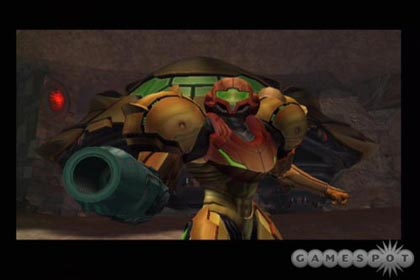
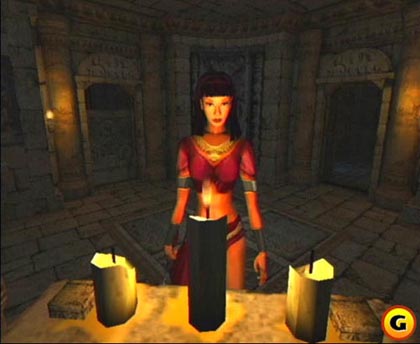 The Gamecube is graphically similar to the Xbox, with only slightly less complex
texture mapping and lighting effects. Despite the popularity within the media
and public of bashing its unique focus as "kiddie", it also has a
large selection of well made and unique exclusive Japanese titles. This is especially
true when it is considered that you can once again play an entire library of
2D games through the GBA to Gamecube adapter. This uniqueness in library makes
for an interesting scenario for multi-platform gamers who want a second console.
The Gamecube stands out the most with its unique library, while the Xbox and
PS2 seem to try very hard to be the best at the same things. On the other hand,
fans of PS1 or PC style gaming, would probably find either the PS2 or the Xbox,
respectively the best choice.
The Gamecube is graphically similar to the Xbox, with only slightly less complex
texture mapping and lighting effects. Despite the popularity within the media
and public of bashing its unique focus as "kiddie", it also has a
large selection of well made and unique exclusive Japanese titles. This is especially
true when it is considered that you can once again play an entire library of
2D games through the GBA to Gamecube adapter. This uniqueness in library makes
for an interesting scenario for multi-platform gamers who want a second console.
The Gamecube stands out the most with its unique library, while the Xbox and
PS2 seem to try very hard to be the best at the same things. On the other hand,
fans of PS1 or PC style gaming, would probably find either the PS2 or the Xbox,
respectively the best choice. There isn't much more to say about the Gamecube that isn't already stated in the N64 section. Quality over Quantity is still Nintendo's PR stance, and arguments for or against whether they've succeeded can and do go either way. Nintendo still comes up with the most unique and innovative titles, that actually work, and the Gamecube still gets the cold shoulder from 3rd parties, possibly as a result of this fact. From 2001 to 2005 the Gamecube sold 18 million units worldwide, 10 million in the United States. It's significant to note that the Gamecube's rate of sale is roughly the same as that of the Dreamcast. However, unlike Sega in the Dreamcast days, or Microsoft and Sony, it is still only Nintendo who manages to turn a profit virtually every quarter. This is often cited as being because of Nintendo's persistent re-publishing of older titles for the Gameboy and Nintendo DS, as well as the proliferation of remakes for the Gamecube. Whether or not Nintendo's rate of rehashing old titles, verses the innovative titles they come up with, is greater than any other 3rd party is a debate that probably has no clear end.
1
http://www.geocities.com/beaucabs/
2
http://www.geekcomix.com/vgh/fourth/nes.shtml
3
http://www.geekcomix.com/vgh/fourth/compare.shtml
4
http://www.geekcomix.com/vgh/fourth/nesbad.shtml
5
http://www.eidolons-inn.net/segabase/SegaBase-Genesis.html
6
http://www.geekcomix.com/vgh/fifth/genesis.shtml
7
http://www.geekcomix.com/vgh/fifth/SNES.shtml
8
http://www.eidolons-inn.net/segabase/SegaBase-SegaCD.html
9
http://www.eidolons-inn.net/segabase/SegaBase-32X.html
10
http://www.eidolons-inn.net/segabase/SegaBase-Saturn(Part1).html
11
http://www.sega.com/segascream/legacy/mastersys.jhtml
12
http://www.nintendo.com/systems/nes/nes_specs.jsp
13
http://www.sega.com/segascream/legacy/genesis.jhtml
14
http://www.nintendo.com/systems/SNES/SNES_specs.jsp
15
http://www.us.playstation.com/consoles.aspx?id=1/info/415007665.html
16
http://db.gamefaqs.com/console/saturn/file/sega_saturn_b.txt
17
http://db.gamefaqs.com/console/dreamcast/file/dreamcast_a.txt
18
http://db.gamefaqs.com/console/ps2/file/playstation2.txt
19
http://www.classicgaming.com/museum/sms/
20
http://www.geocities.com/rabidsmily/Hardware/Sega_Master_System/SegaMasterSystem.html
21
http://www.nintendo.com/systemsclassic?type=nes
22
http://db.gamefaqs.com/console/psx/file/sony_psx.txt
23
http://groups.google.com/groups?q=sony+psx+specs+1+million+flat+shaded&hl=en&lr=&selm=MSGID_242%3D3A5000%3D2F22.5_b70d2908%40Fido.DE&rnum=5
24
http://groups.google.com/groups?q=sony+psx+specs+1+million+flat+shaded&hl=en&lr=&selm=35d8d75a.12024831%40news.ns.net&rnum=4
25
http://www.classicgaming.com/museum/faqs/jaguarfaq.shtml
26
http://www.classicgaming.com/museum/faqs/3dofaq.shtml
27
http://groups-beta.google.com/group/rec.games.video.3do/browse_thread/.....
28
http://groups-beta.google.com/group/rec.games.video.sega/browse_thread/thread/.....
29
http://www.classicgaming.com/museum/tg16/
30
http://www.classicgaming.com/museum/faqs/tg16faq.shtml
31
http://groups.google.com/group/z-netz.freizeit.consolen/msg/b1cc002c557bb2cf
32
http://www.emulationzone.org/consoles/tg16/tg16.htm
33
http://www.pcvsconsole.com/features/consoles/gen4.php
34
http://www.pcvsconsole.com/features/consoles/
35
http://groups.google.com/group/alt.games.video.sega-dreamcast/msg/538573c34e6eb110
36
http://groups.google.com/groups?q=Capcom+Producer+Sony+Square&hl=en&lr=&ie=UTF-8&oe=UTF-8&selm=3D6B0FC3.6781AF82%40excite.com&rnum=1
37
http://db.gamefaqs.com/console/gamecube/file/gamecube.txt
38
http://db.gamefaqs.com/console/xbox/file/xbox_b.txt
39
http://forum.pcvsconsole.com/viewthread.php?tid=14306
40
http://www.planetdreamcast.com/rems/news.html
41
http://www.totalvideogames.com/news/Polygon_Problems_For_PS2_RE4_7159_4272_0.htm
